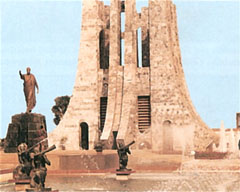|
Ghana is the first African country south of the Sahara to achieve independence in 1957.
Ghana lies at the heart of a region which has been leading sub-Saharan African culture since the first millennium BC in
metal-working, mining, sculpture and agriculture. Modern Ghana takes its name from the ancient kingdom of Ghana, some 800
km. (500 miles) to the north of present-day Accra, which flourished up to the eleventh century AD. One of the great sudanic
states which dominate African history, the kingdom of Ghana controlled the gold trade between the mining areas to the south
and the Saharan trade routes to the north. Ancient Ghana was also the focus for the export trade in Saharan copper and salt.
The coming of Europeans altered the trading patterns, and the focus of economic power shifted to the West African coast-
line. The Portuguese came first, seeking the source of the African gold. It lay too far inland for them to reach; but on the
Gold Coast they found a region where gold could be obtained, exported along established trade paths from the interior. Their
fort at Elmina ("the mine") was the first in a series of forts along the Gold Coast designed to repel the other
European seafarers who followed in their wake, all struggling for their share of the profitable Gold Coast trade. In due course,
however, slaves replaced gold as the most lucrative trade along the coast, with the European slave buyers using the forts
and adjoining buildings for their own accommodation and protection, as well as for storing the goods, mainly guns and gunpowder,
which they would barter for slaves. Some of the forts were also used for keeping newly acquired slaves pending the arrival
of the ships sent to collect them.
The history of the various forts, given later in this guide, graphically expresses how the various European trading nations
fought for our gold, ivory and later, slaves. But while Europeans quarreled over access to the coastal trade, and despite
the appalling depredations of the slave traders, which left whole regions destroyed and depopulated, the shape of modern Ghana
was being laid down. At the end of the 17th century, there were a number of small states on the Gold Coast;
by 1750, these had merged, by conquest or diplomacy, into two: the Asante empire, and the Fantes. By the 19th century,
the Asantes were seeking mastery of the coast, and especially access to the trading post of Elmina. By this time the British
had won control of the coastal trade from the other European nations, and their interests could not tolerate further Asante
expansion - more so since the Asante Empire was known for its sophisticated administrative efficiency and would have been
difficult or impossible to best at trade. Nevertheless it took a series of military campaigns over some 50 years before the
British were finally able to force the Asantes to give up sovereignty over their southern possessions. In a final campaign
in 1874 the British attempted, without success, to seize Asante; they were however able to take Kumasi and exact a huge ransom
for it in gold; and the vast Asante empire shrunk to the Asante and Brong-Ahafo regions of modern Ghana. Meanwhile, the Fantes
too had been uniting and organizing, and in 1868 formed themselves into a confederacy under a king-president with a 15,000
strong army, a civil service and a constitution. In 1871 the British arrested the Fante leaders for "treason". They
were however freed a month later, but the con- federacy never recovered from the blow. In 1874 the British formally established
the British Crown Colony of the Gold Coast, "legalizing" a colonial policy which had in fact been in force since
the signing of the bond between the coastal Chiefs and the British in 1844, despite the fact that the Chiefs never ceded sovereignty
to the British under the bond, though some of them allowed British intervention in judicial matters. The Asante and Fante
traditions of education and organization, and their urge for autonomy, remained throughout the years of British colonial rule.
The Gold Coast was regarded as the showpiece of Britain's colonies: the richest, the best educated, the first to have an elected
majority in the legislature and with the best organized native authorities.
The Gold Coast riots in 1948, which marked the start of the people's agitation for independence, were instrumental in
changing British policy and drove home the point that colonialism had no future.

The Slave dungeons of Cape Coast Castle-Millions of Slaves perished here.

|
| Elmina Castle, the first European built structure south of the Sahara. |
But a long struggle still lay ahead - and the man who was the catalyst of that struggle was Dr. Kwame Nkrumah Born in 1909,
Dr. Kwame Nkrumah trained as a teacher at Achimota College in Ghana and then in the United States and Britain, where he obtained
his degrees. He became prominent as a leader of West African organizations in London and was invited to return to Ghana as
general secretary of the United Gold Coast Convention. In 1949 he broke away to from the Convention People's Party with the
slogan Self-Government Now. In February 1951 the party swept to victory in the polls and became the leaders of Government
business in the colony's first African government. The Gold Coast had become the first British colony in Africa to achieve
self-government. On 6 March 1957 Ghana achieved independence - again, the first British colony in Africa to do so - with Osagyefo
Dr. Kwame Nkrumah as its first Prime Minister. On 1st July 1960 it became a republic with Kwame Nkrumah as its first President.
Ghana spearheaded the political advancement of Africa and Dr. Nkrumah laid the foundations for the unity later expressed in
the formation of the Organization of African Unity (OAU). He was a firm supporter of the Commonwealth and the Non-Aligned
movement.

|
| Kwame Nkrumah Mausoleum |
This museum holds the remains of the first President of Ghana Osagyefo Dr Kwame Nkrumah. The Museum was created in his honor
after which his body was exhumed from his original burial grounds at his home town-Nkroful
Population
The population of Ghana is 18,845,265 (Source: Ghana Statistical Service, January 2002). The country, with ten regions, has
on average a population density of about 78.9 persons per square kilometre, with an annual growth rate of 2.6 per cent.
Most of the population is concentrated in the southern part of the country, with the highest densities occurring in urban
areas and cocoa-producing areas.
Ghana is and has always been a special part of Africa. An Africa with a wide range of attractions and facilities. It dazzles
you with its historic past, and charms you with that natural beauty which envelopes you wherever you go. Indeed for the traveller,
Ghana is that latter-day unknown, unexplored and certainly unexploited destination which abounds in an unbelievable array
of excitingly striking attractions, succinctly distinctive and peculiar to each of the ten regions in Ghana. There are miles
and miles of sun drenched and unspoilt beaches to discover as well as national parks which boast of unique flora and fauna.
The centuries-old traditions of the people of Ghana and the diversity of the distinct ethnic groups, have created a rich
culture that is the splendid legacy of modern Ghana.
To the people of Ghana, the traditions of their ancestors are still an important part of daily life. Customary leaders
have historical authority over tribal and family matters, and customary lands are an important heritage.
Important events in life are marked by special rites and rituals. Child naming, puberty initiations, marriage and death
are marked by family ceremonies, while seasonal festivals bring a whole people or clan together in spectacular fashion.A common
feature is the belief in the Supreme Being, in life after death and in the nearness of dead ancestors. Festivals also recall
past events, and consecrate a new season with confidence and hope.
Traditional fetish shrines, sometimes concealed but more often displayed, are important centres of worship and traditional
healing, and an influential part of traditional life.Of special significance are the Posuban shrines, particular to the Fante
communities in Southern Ghana. Fanciful buildings lavishly decorated with folk art, they are religious centres for Fante warrior
organisations.
Accra, the capital city.

|
| Accra |
All year round Summer Season
Ghana has a tropical climate, characterised most of the year by moderate temperatures generally 21-32°C (70-90°F), constant
breeze and sunshine. There are two rainy seasons, from March to July and from September to October, separated by a short cool
dry season in August and a relatively long dry season in the south from mid-October to March. Ghana has an almost all year
round summer season.
Public Holidays
Holiday Date
New Years Day 1st January
Eid ul Fitr Variable (As the position of the Moon (Ramadan Festival) determines the day it is celebrated)
Independence Day 6th March
Good Friday Variable
Easter Monday Variable
Eid ul Adha 70 days (10 weeks) from Eid ul Fitr (Festival of Sacrifice)
Workers Day 1st May
Africa Day 25th May
Republic Day 1st July
Farmers Day 1st Friday in December
Christmas Day 25th December
Boxing Day 26th December
|

